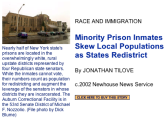Ten years ago today, Tilove article put prison-based gerrymandering on the national map
First national article to explain prison-based gerrymandering is still timely.
by Peter Wagner, March 12, 2012
The first major national article about prison-based gerrymandering appeared ten years ago today. Jonathan Tilove, then the race and immigration reporter for Newhouse News Service, wrote a major feature that connected the dots between my academic research on how the Census Bureau’s prison counts distort democracy in the New York State legislature, Taren Stinebrickner-Kauffman’s research on prison demographics in Florida, and the redistricting struggles of county officials in Colorado, Louisiana and Florida.
To quote from Jonathan’s article, at the time the “issue [hadn’t] gained much serious attention or debate at the national or state levels.” But the article changed all that.
As I wrote on the 10th anniversary of the founding of the Prison Policy Initiative:
Prior to Jonathan’s article, explaining my research used to take hours. His piece helped us succinctly explain who benefits from prison-based gerrymandering. For example, in a single clear sentence Jonathan powerfully summarized one concept that used to take me 15 minutes to explain. Many of the innovations in Jonathan’s article informed how we constructed our “Importing Constituents” report, and Jonathan’s discussion of intra-rural impacts inspired our strategy for the next decade.
The article’s publication introduced our work to Brenda Wright, then managing attorney at the National Voting Rights Institute, and now Director of the Democracy Program at Demos. Brenda reached out to share her expertise and has been one of our closest advisors and colleagues ever since.
The movement to abolish prison-based gerrymandering has come along way since Jonathan’s article was written, with advances such as:
- The publication of dozens of reports on how prison-based gerrymandering distorts democracy in state and local governments across the country
- The New York Times editorial board coining the term “prison-based gerrymandering”
- Four states passing legislation to end prison-based gerrymandering
- The Census Bureau changing how prison count data is published
- Hundreds of counties and municipalities refusing to engage in prison-based gerrymandering
There’s been great progress since 2002, but the article is still a concise introduction to the problem, and a powerful explanation of how the Census Bureau’s prison miscount is bad for both urban and rural people. In Iberville Parish Louisiana, prison-based gerrymandering would have meant drawing a school board district that had only two voters. In the New York Senate, legislators who supported prison expansion boasted that they were glad that people incarcerated in their districts couldn’t vote because “they wouldn’t vote for me”.
Ten years ago, prison-based gerrymandering was virtually unknown. The issue was intriguing but complicated and obscure. Jonathan Tilove’s article was the first to focus on this problem and to give the public the tools they need to understand why prison-based gerrymandering needed to be abolished.
If you missed his article ten years ago, or if you haven’t read it again recently, today is a great time to read it again.




